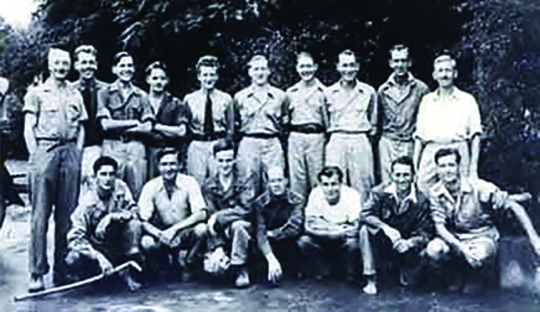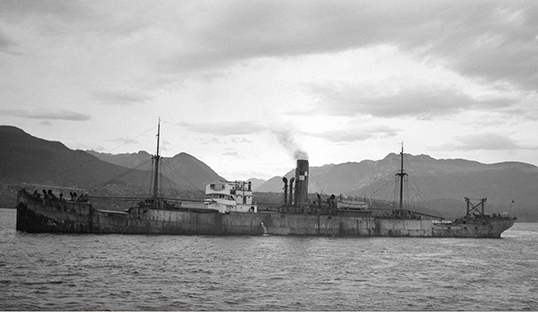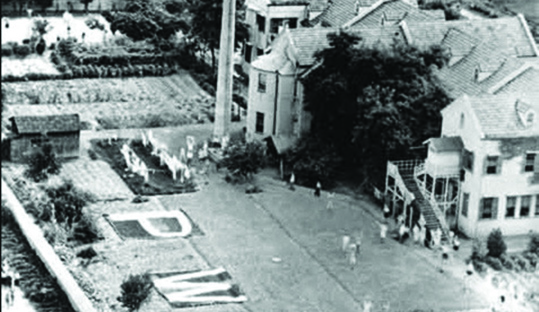- Topics
- Campaigning
- Careers
- Colleges
- Community
- Education and training
- Environment
- Equality
- Federation
- General secretary message
- Government
- Health and safety
- History
- Industrial
- International
- Law
- Members at work
- Nautilus news
- Nautilus partnerships
- Netherlands
- Open days
- Opinion
- Organising
- Podcasts from Nautilus
- Sponsored content
- Switzerland
- Technology
- Ukraine
- United Kingdom
- Welfare
Captive in Fukushima – a Merchant Navy chief officer's testimony from the Second World War
5 October 2020

Although the Atlantic Convoys of WW2 are fairly well known, many people do not realise that merchant vessels were also involved in the Pacific theatre of war. Some Allied merchant seafarers were even sent to the notorious Japanese prisoner of war camps, as Andrew Linington recounts
When the British merchant ship Kirkpool was sunk by a German warship in the south Atlantic in April 1942, the surviving crew members had little idea that this was to be just the start of a long ordeal that would continue to the war's end.
In a detailed and moving 14-page document discovered in the Nautilus archives, the ship's 27-year-old chief officer provided a remarkable account of the sinking of the 4,840grt general cargoship and his subsequent time as a prisoner of war in Japan.
Three officers and 11 ratings from the Ropner vessel Kirkpool, 10 days into a voyage from Durban to Montevideo with a cargo of coal, were killed when it became one of a dozen British, Dutch, Norwegian, Swedish and Greek merchant ships to fall victim to the German cruiser Thor.
The 32 surviving crew were picked up by Thor and transferred to the German supply ship Regenburg and then taken onto the German merchant ships Dresden and Ramses.
Imprisoned in Japan
Having initially been told that they would probably be put ashore in a neutral port to make their way home, the Kirkpool survivors' worst fears were confirmed when it became clear that they were being taken to Japan, along with passengers and crew from other merchant vessels which had been attacked, including the British vessels Wellpark, Willesden and Nankin, and the Norwegian ship Aust.
Formally transferred to the custody of Japanese authorities in Yokohama in July, three months after their ship was sunk, the Kirkpool's crew were split up. Some – including the ship's master, Captain Albert Kennington – were sent to a prisoner of war (PoW) camp at Yokohama, while 17 others were sent to an internment facility at Fukushima, in the north of Japan's main island.
The 140 prisoners at Fukushima were all passengers or crew from merchant ships attacked by the Germans. The seafarers were comprised of 24 British nationals, 19 Greeks, nine Chinese, six Africans, five Arabs, one Spaniard and one Armenian, while the 42 women and children were kept isolated from the men in another part of the building.

Built in 1928, the Ropner vessel Kirkpool was sunk by the German cruiser Thor in April 1942. Image: City of Vancouver Archives
Chief officer's testimony
Among the internees was Kirkpool's chief officer, Olaf Olsen, a British seafarer from Cleethorpes, Lincolnshire, whose first-hand account was given to the Navigators' & Engineer Officers' Union. 'We could hardly have been a more cosmopolitan crowd,' he noted at the start of his account.
Although the prisoners had been told they were lucky to have been sent to the Fukushima facility – a requisitioned Catholic convent on the outskirts of the town – Mr Olsen said 'atrocious physical maltreatment' rapidly became the norm, with the captives being warned on the day of their arrival that reprisals would be taken if the success of the Japanese armed forces did not continue.
'We were treated as though we were vicious criminals,' he wrote. 'The guards were under absolutely no discipline, each could compel any prisoner, groups of prisoners or the whole camp to suffer insult or humiliation whenever he felt the whim to do so.
'We immediately recognised how precarious our position was as secret prisoners isolated from outside authority,' he added. 'It seemed plain that our only chance of survival was to be docile towards our captors. This policy was followed by us all from the beginning.'
From bad to worse
Mr Olsen said the prisoners were issued with new regulations on an almost daily basis. 'These were obviously designed to make us feel the unpleasantness of our situation as much as possible, and afforded ample scope for persecution by the guards, who took full advantage of this situation.'
Things rapidly went from bad to worse, with two of the older prisoners – including the fourth engineer from the Denholm ship Wellpark – dying within the first few weeks. 'During the first three months, by starving us and withholding tobacco from smokers, the Japanese made a calculated effort to break our spirit,' Mr Olsen recalled.
Food was frequently in such short supply that the prisoners were forced to eat weeds from the garden, and most of the adults had lost 25 pounds in weight within the first six weeks. 'At the end of our imprisonment, the average loss was 45 pounds, some men had lost 90 pounds each,' Mr Olsen wrote. 'Nearly all suffered from stomach disorders, headaches, weakness, blackouts, dizziness, boils, chilblains and bad eyes due to malnutrition.'
Official records show that Mr Olsen – who lost 58lbs in weight during captivity – was one of six prisoners who arrived at Fukushima with incompletely healed wounds. 'In the early days, those of us who still had open wounds caused by enemy action could get absolutely nothing for dressings,' he wrote. 'The original bandages had to be used, no soap was available to wash them.'
Punishments were given out for small and petty offences, and to anyone who sang, whistled or showed any appearance of being happy. 'The most common form of punishment was being hit hard across the face many times, and often in addition being tripped up and kicked,' Mr Olsen noted.
Red Cross intervention
For the first two years of captivity the PoWs had no contact with the outside world, but in March 1944 their treatment improved considerably and towards the end of the month a Red Cross representative visited the camp. Soon afterwards, the first food parcels and medical kits sent by the organisation arrived, and permission was given to write their first letters home.
The improved conditions did not last long, however, especially when the prisoners attempted to describe their treatment to an independent 'Protector's Power' delegate from Switzerland.
When US forces began to close in on Japan later in 1944, the prisoners were warned that the Japanese would fight to the death and kill all their captives.
'Towards the end of our imprisonment it became more evident than ever that the local authority was a law unto itself, being only in a very small degree responsible to higher authority,' Mr Olsen reflected. 'Each petty official down to the lowest rank succeeded in being despot of his own sphere, without fear of retribution from his superiors.'
In April 1945 the Red Cross made a second visit to Fukushima, and in July the Swiss Protector Power delegate returned and promised to take up the prisoners' complaints of cuts in their food rations, which had left them with just dry bread and water.

The Fukushima internment camp, pictured from a US aircraft at the end of the war. Image: Roger Mansell, Palo Alto, CA
Surrender and release
But on 16 August, the prisoners learned that Japan had surrendered. US aircraft dropped food and other supplies on the site, and on 10 September the captives began their long journeys home, undergoing treatment onboard the US hospital ship Rescue before sailing to Sydney and then returning home onboard the troopship Andes, arriving in Southampton just in time for Christmas.
Reflecting on his time as a PoW, Olaf Olsen blamed the Japanese government for the maltreatment the captives suffered, with 'continual isolation' and a lack of oversight allowing abuses to take place. 'Those placed in charge of us have been entirely unfitted for such a duty, being undisciplined and incapable of keeping under control their ever-present desire to treat us as active enemies,' he wrote.
His account also admits to difficulties in maintaining morale through the long and arduous captivity. 'It can be understood that there was not always unity amongst the prisoners, seeing that they were so diverse in race, creed and temperament,' he noted.
'Commendation is due to the Kirkpool's survivors for their self-restraint and high standard of conduct and loyalty throughout the term of imprisonment,' the papers conclude.
After the war
What Olaf Olsen did after the war is not clear, although records show he became a captain and died, at the age of 90, in Grimsby. Kirkpool's radio officer, Malcolm Ingleby Scott – whose family had been told in 1942 that he was missing, presumed dead – was said to have never fully recovered from his time as a PoW and died at the age of 53, 14 years after release. Captain Kennington died in captivity in 1944.
More than 5,700 British merchant seafarers were held as PoWs during the Second World War – most of them detained at the Milag camp in Germany, as well as in Japan, Penang, Java, and west and north Africa.
The Navigators and Engineer Officers' Union made strong representations on behalf of Merchant Navy prisoners both during and after the war, seeking to ensure that the Geneva Convention rules covering their treatment were adhered to, and to increase their detention allowances. Disability pensions were paid to any members whose eyesight was so badly affected by vitamin deficiencies that they could no longer go to sea.
Tags
